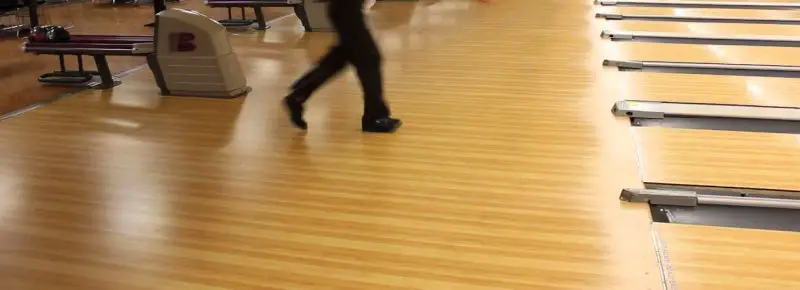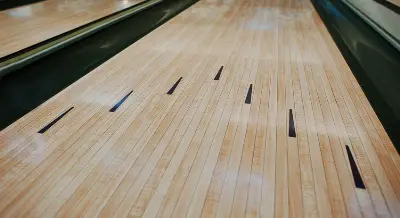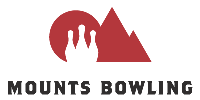
There are tons of things to measure on a bowling lane! Way more than you even realize but they are all standardized measurements that make a big difference.
Most bowlers know that it’s 60 feet from the foul line to the head pin but they don’t know a whole lot else so lets dive into it.
Basic Lane Dimensions and Specifications
The lane specs are as basic as it gets.
The foul line is 60 feet to the center of the headpin and the pin deck extends an additional 2 feet 10 3/16 inches beyond that.
The bowling lane is 39 boards wide totaling 41.5 inches making each board 1.06 inches in width.
On the left and right side of the lane are two gutters which sit lowered from the lane surface by 1 7/8″. Each gutter is a full 9 1/4″ in width fitting a bowling ball in them with a little extra wiggle room.
Dimensions of the Bowling Approach Area

Every bowling approach area has the same characteristics it must adhere to for regulation purposes but there is some room for each center to do it slightly differently.
For starters the approach must be at least the width of the lane and it must extend at least 15 feet back from the foul line.
There are two sets of dots near the back of the approach. The first set is 15-feet from the foul line and the second set is 12-feet from the foul line.
Each dot corresponds to the 5, 10, 15, 20, 25, 30, and 35 board just as the arrows do.
Their is also a third set of dots on the same boards located 2-4 inches away from the foul line which help a bowler located the proper board to slide on or place the ball down on at the moment of release.
The two most common things that differentiate one approach from another is the width of the ball return and the step (or lack thereof) up from the settee area onto the approach.
Some centers have no step up at all while others have a 4-5 inch step up.
As for the ball return some extend closer to the foul line than others while some can be quite wide encroaching on a bowlers stance or walking path.
It is the bowlers responsibility to deal with these changing variables just as he or she would adjust to the variables of conditioner on the lane.
The Arrows on a Bowling Lane
 Of all the dimensions on a lane the arrows are the variable that is not exact. Bowling lane specifications leave room for manipulation in this area.
Of all the dimensions on a lane the arrows are the variable that is not exact. Bowling lane specifications leave room for manipulation in this area.
The USBC actually only gives guidance on a range of dimensions for these that must be adhered to.
The arrows must start no earlier than 12 feet from the foul line. They are roughly one board wide (approx 1.08″) and cannot exceed 1.25″ in width.
There is no guidance on the length of each arrow except that they cannot be more than 6″ long.
The end of the middle arrow cannot be further than 16-feet down the lane.
For this reason most dimensions notate that arrows are roughly 15-feet down the lane but in some centers the first arrows may be as close as 12-feet.
They are however placed on standard boards, the 5, 10, 15, 20, 25, 30, and 35 boards in the shape of a “V”. The middle arrow is the furthest down lane.
Here is a likely scenario found in an average bowling center:
The first arrows are located on the 5-board and the 35-board starting at the 14-foot mark and ending at 14.5 feet.
The second set of are arrows located on the 10-board and the 30-board starting at the 14.5-foot mark and ending at 15 feet.
The third set of arrows are located on the 15-board and the 25-board starting at the 15-foot mark and ending at 15.5″.
The last arrow is located on the 20-board starting at the 15.5-foot mark and ending at 16 feet.
The Location of the Location Markers (Breakpoint Markings) Down Lane
There is no requirement for a bowling lane to include darkened hash markers and many of them don’t but I would wager than the majority of modern lanes these days do include them.
Unlike dots and arrows there are only four of them.
The first set is located on the 15 and 25 boards starting at 34-feet and ending at 37-feet down lane.
The second set is located on the 10 and 30 boards starting at 40-feet and ending at 43-feet down lane.
It is common for bowlers to use these marks as a reference point for a balls exit location on a given pattern in relation to the balls major break point.
Although their is no rule that a lane have these marks or adhere to exact placement virtually every bowling lane that uses the hashmarks places them in the exact same spots.
Dimensions and Specs Related to the Pin Deck
The pin deck extends an extra 2-feet 10 3/16 inches beyond the lane. After the pin deck is an extra three inches of tail plank making the total length of the bowling lane from the foul line to the pinsetter machine a whopping 65′-10 3/16″.
The headpin of course sits in the middle of the lane at 60 feet and each pin sits exactly 12 inches apart measured from center of any pin to center of it’s adjacent pin, in the shape of an equilateral triangle.
Because each pin is 4.75″ wide at it’s widest point there is a gap between each neighboring pin of 7.25″, just enough for a bowling ball to pass between two side-by-side pins and hit them both.
There are four rows of pins, the first row consists of only the head-pin. Each subsequent row behind behind sits an extra 10-3/8″ inches back measured from center of the head pin to the center of the pin line on the next row.
Each pin within a single row is exactly 10 boards apart on center putting the 1 & 5 pins centered on the 20th board, the 3 & 9 pins centered on the 15th board, the 2 & 8 boards centered on the 25th board, the 6-pin centered on board 10, the 10-pin centered on the 5-board, the 4-pin centered on the 30th board, and the 7-pin centered on the 35th board.
Lastly, behind the pin deck and tail plank the pinsetter curtain sits another 14-inches back while the lowered pit sits roughly four inches below the lane surface. These last measurements vary to some extent however as they are not hard defined by the USBC, the governing body overseeing the sport of bowling.
As you may be able to see, most of the specs for bowling lanes are standard all across the world but there are a few points that are flexible which may be the reason why some centers are known to carry better or worse and why some centers targeting arrows cause some bowlers to have to make mental adjustments that they don’t normally have to make in other centers.

